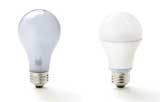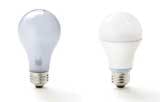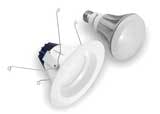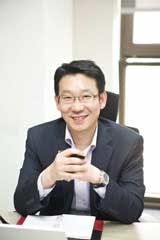This article was published in the June 2013 issue of LEDs Magazine.
View the Table of Contents and download the PDF file of the complete June 2013 issue, or view the E-zine version in your browser.
+++++
Lightfair International (LFI) 2013 marked the dawn of a new attitude among many top executives at both LED and lighting companies — and realize that some of the companies we will discuss are vertically integrated, building their own LEDs and solid-state lighting (SSL) products. However, across the board, the largest players have settled into strategies intended to seize the opportunity being presented by a transition to LED lighting. The companies are also in a sense going back to basics and making sure they get fundamentals such as thermal management, optical performance, and aesthetics right. Meanwhile the executives all recognize that their companies must execute on emerging trends such as tunable lighting, both color and white point, and a transition to networked lighting.
The SSL industry has hit a clear fork in the road with a lot of short-term interest in LED-based replacement lamps, but more long-term belief in integral luminaires that may have little resemblance to legacy fixtures. Let's first consider developments in lamps.
Clearly the industry is moving toward products that mimic the look of legacy products, despite the fact that the look of the lamp is hidden in many applications. That trend became evident when Philips Lighting first introduced an A-lamp with a white optic in the shape of its yellow/orange EnduraLED lamps last December, then followed with a lamp sporting a more traditional rounded globe in March.
Legacy lamp looks LFI revealed a continuation of that trend with GE Lighting introducing a new LED lamp in its Reveal branded family (Fig. 1). Reveal is a premium line that GE touts as being superior for rendering colors and revealing nuanced patterns and textures. But the push around the LED-based Reveal lamp was its resemblance to legacy looks, whereas prior GE LED lamps have featured visible heat fins that extend vertically over sections of the globe.John Strainic, general manager for North America consumer lighting, said Reveal buyers are "loyal and discriminating." And evidently the new design was driven by consumer research. "At the forefront of all of our engineering is consumer research, and we heard across the board that the size and the shape of an LED bulb is very important to shoppers," said Tom Boyle, chief innovation manager at GE Lighting. GE showed a Reveal A-lamp due to market shortly for 40W and 60W replacements and said a BR-30 is coming as well.
The maturity of both LED components and lamp design, especially in thermal management, enables products with a traditional look and no evident heat sinks. LEDs with higher efficacy produce less heat and can be driven at lower currents to further reduce heat. However, lamps designers and materials companies are ultimately enabling the change. See our recent feature on thermal products for a look at the technologies available to mitigate heat, including moldable thermoplastics that can conduct heat.
Philips first produced BR and PAR lamps with a legacy look when it introduced its AirFlux-branded products at LFI 2012. Now the same technology is being applied to A-lamps. Bruno Biasiotta (Fig. 2), president and CEO of Philips Lighting, said that having Lumileds as a vertically integrated part of the company has been vital to making rapid progress in lighting whether it was developing the L Prize winner or the new lamps with a legacy look. The two divisions work closely in areas such as thermal mitigation. However, other companies such as GE are also moving forward without in-house LED manufacturing, and we will discuss vertical integration more a bit later.Tunable lighting
Perhaps the strongest trend at LFI was tunable lighting as it emerged as a near mainstream technology. It's tough to overstate how much the Philips Hue product has done to move the technology along as it proved that color tuning could be relatively affordable. Indeed, that product was recognized with the Judges' Citation Award and as the winner of the dynamic color category in the Lightfair Innovation Awards.
At Lightfair, Philips announced a BR30 Hue lamp that will offer 65W equivalence and is due on the market in the fall. When asked why Philips introduced the lamp so far in advance of availability, Philips' Biasiotta said the company wanted to emphasize its commitment to the Hue technology. Indeed, he said a GU10 version would also be coming later this year.
Still, it's in luminaires where tuning will become most prominent. Acuity, for example, demonstrated compelling tunable-white and dynamic-color products in its private demo area. The Aera concept product was among the most impressive on the massive exhibition floor.
Peter Laier, CTO of Osram, noted the trend and described recent Osram work in the area. He said that the company had partnered with a Munich museum and developed a color-tunable luminaire that uses five colors of LEDs. The yet-to-be-detailed product is what Laier called a "classical pilot project." He said the design realizes a CRI of 95.
In the exhibit area, Osram Sylvania demonstrated tunable white point technology that in its case was implemented for aesthetics. The company has both lamps and fixtures that implement what it calls the Sunset Effect — a transition in CCT from 3000K to 2000K as the light is dimmed to mimic incandescent performance.
Networks and control
Of course, with tunable lighting, the need for lighting networks is even more pronounced, although energy savings through programmatic control and dimming is probably sufficient to ultimately drive network adoption. Network-centric LFI demonstrations ranged from individual lamps to building-level systems.
Samsung, for example, introduced a ZigBee-enabled lamp due this fall, but it's based on the ZigBee Home Automation standard. That standard requires a centralized controller, whereas Light Link allows plug-and-play links between, for example, a wall controller and a lamp. But Samsung is approaching the technology with a broader view of offering appliances that would all connect with ZigBee Home Automation support.
Hubbell and Lighting Science Group both demonstrated products with Bluetooth wireless — the same technology already built into our mobile phones. Bluetooth in lighting can allow for simple commissioning with mobile devices, but doesn't offer the range needed in a persistently connected system.
Acuity Brands is the best illustration of the fragmentation in networks. The company has a proprietary wired network called nLight that runs over Ethernet network cables and was developed by the Sensor Switch brand. That family also now includes the option of Wi-Fi networks. The company also recently acquired Adura Technologies that uses proprietary protocols on top of ZigBee lower layers. The Roam brand sells ZigBee-based proprietary technology as well.
Companies such as Cree, Philips, and GE have dabbled in multiple control technologies by partnering with controls companies. Both have products that integrate support for Lutron’s proprietary EcoSystem wired network. Lutron can extend EcoSystem networks with its own proprietary wireless links.
Open standards
The best news at the show was that executives from what are sometimes called the big three in lighting — Osram, GE, and Philips — all pledged support for open standards going forward. Open standards will hopefully allow interoperable products from many vendors.
Osram's Laier, for example, is a proponent of open standards, saying, "That needs to be the case." Philips' Biasiotta concurred. He said Philips will attempt to sell lighting systems that completely meet customers' needs and ultimately believes that the company will transition to a lighting-as-a-service business model where customers essentially rent their lighting. But he said the company would never stand in the way of a customer adding a needed product from another vendor into the mix. Neither executive had an answer, however, as to exactly which network will win out, although as we mentioned, both are using ZigBee in some products today.
GE's Jaime Irick, general manager of North America professional solutions, meanwhile, revealed that it was supplying new wireless control technology and network to the City of Los Angeles for use in what is the largest installation of street lights in the world. That project will utilize LoWPAN (IPv6 over low-power wireless personal area network) that allows each light to be a node on the global Internet. Indeed, 6LoWPAN is the technology most often associated with the technology movement referred to as the Internet of Things.
While GE didn't identify concrete network plans, Irick said the company will take lessons learned in the, project and apply them to other places. He also said the company is committed to open standards.
As to whether ubiquitous network control will happen in lighting, there seems little doubt. Philips' Biasiotta said, "There isn't a smart city or a smart gird without smart lighting." Another Philips executive had voiced similar feelings at the Street and Area Lighting Conference last year, noting that controls were the only affordable way forward with a growing populace demanding more lighting.
Packaged LEDs
LFI also provided an opportunity to discuss the latest in the LED component space and the business of LED manufacturing with top executives. Several announcements at LFI or just before tie into the color-tuning SSL trend. Osram Opto Semiconductors, for example, announced five color LEDs in its mid-power Duris family at the show. The color LEDs can be closely packed to enable tunable lighting even in replacement lamps. The company also announced a deep-blue Duris optimized for remote phosphor applications.
Just prior to LFI, Philips introduced new products in the tiny 1.6x2-mm Luxeon Z ES family of high-power LEDs, including both tunable white and colored emitters. Indeed, the family includes the same color LEDs used in the Hue lamp, including the first commercial availability of the lime-green LED technology that Philips has said was vital in Hue delivering 90 CRI white light.
At LFI, Lumileds CEO Pierre Yves Lesaicherre confirmed that the lime-green Luxeon Z ES LED is made with the same recipe as the one in Hue, but at this point has a smaller die than the actual LED used in Hue.
Lumileds announced its first chip-on-board LEDs at LFI in the Luxeon CoB family with efficacy up to 120 lm/W and flux output up to 6000 lm (Fig. 4). Lesaicherre said that the company had not offered COB LEDs before because you could achieve much tighter beam control with smaller point sources. However, he added that the market is now demanding COB LEDs because product development is much simpler with a single packaged LED even if it integrates many emitters under the phosphor.Lesaicherre did claim that Lumileds has developed a COB product with uniformity and light quality that exceeds other such products on the market. He said, "We optimized the phosphor for the light emitting surface."
Crowded market
The bigger LED news at LFI, however, may have been the high-profile presence of Korean suppliers Samsung and LG Innotek. Samsung announced new COB LEDs at the show with flux output up to 5000 lm and maximum efficacy of 129 lm/W. Just prior to LFI, Samsung had announced mid-power LEDs with efficacy of 160 lm/W, and LG topped that at LFI with an announcement of 170-lm/W mid-power devices.
The two have both moved their component focus squarely onto the general illumination market. Both have been among the leaders in packaged LED sales with Samsung ranked two and LG ranked four by Strategies Unlimited. Although both companies have sold the majority of their devices into backlighting applications in the past, they see their future in lighting applications.
LG is rather a late entrant into LEDs, but has rapidly gained ground. Harry Kang, vice president of the LED lighting business division (Fig. 5), said that the company spent $1.2 billion in research and development over the course of 2010/11. He said the company has the capacity to manufacture 2.5 billion chips per month.The year 2012 was an important one for LG's move into lighting. Kang said that the company has faced roadblocks in the move, such as the lack of LM-80 testing data. But he said that LG completed LM-80 testing on 13 LED models in 1012, and will complete 20 more in 2013.
Thus far, the company is having more success in the mid-power segment, according to Kang, but it does have high-power and COB LEDs, and modular light engines available as well. Moreover, LG will follow a path seen in other industries in cloning a competitor's product. Kang said the company will offer a product that is much like the Cree XP-G2 LED in the third quarter.
Shakeout coming?
Of course, there is question as to whether the market can accommodate more LED makers focused on lighting. Indeed, it makes you wonder if GE has had the right strategy as a lighting company all along — letting others make the low-price LED sources while concentrating on more-expensive, higher-margin systems. But don't expect the likes of Cree, Osram Opto, and Lumileds to scare easily. Indeed Osram's Laier said the company is intent on expanding the Opto business. He claims the company is in a strong number two position globally, although Strategies Unlimited places Osram Opto third in its ranking.
Cree, Lumileds, and Osram each believe that its in-house LED technology offers a strategic advantage in lighting. Laier said, "We have a clear strategy to be a vertically integrated lighting company." He said Osram is the largest such company globally, has more than 20,000 patents in the segment, and can leverage the best cross-licensing portfolio in the industry. Conversely, when asked about the lack of in-house LED manufacturing capability, GE Lighting's Irick said the company was happy with its position and ability to buy the best technology on the market for any given application.
Vertical integration may ultimately segment the playing field among LED manufacturers. Market leader Nichia has repeatedly said that it will not make lighting products and compete with its LED customers. LG's Kang made the same statement at LFI. Nam-seong Cho, executive vice president and head of the LED business at Samsung Electronics, said that Samsung will offer retrofit lamps as part of its consumer electronics portfolio, but will leave the professional lighting market to its customers. However, Cree, Osram, and Philips see higher profits downstream.
Pace of change
What all of the LED makers face in the transition to SSL is both the complexity of LED-based lighting products and matching the pace of change in the disparate LED, semiconductor, and lighting-system worlds. LEDs, as a disruptive technology, have created a series of challenges for the lighting industry. Osram's Laier said that just the transition to the new source, that required new power-conversion technology, thermal mitigation, and new optics, would have been a tremendous challenge. But he said the new applications and form factors enabled by LEDs have layered on additional challenges for SSL manufacturers. And on top of the first two challenges you have what Laier called solution-level challenges such as the addition of networks and controls. The lighting industry is clearly struggling to deliver products and technologies across the breadth of the opportunity.
Top those challenges with the fact the LED manufacturers are rolling out new products on a six-month cycle whereas specific luminaire models have had lifecycles measured in years if not decades. Laier said, "I think the lighting industry can learn more from other industries," meaning in terms of cooperation. He specifically cited thermal as an example where companies have each pursued its own technologies and product designs whereas there could have been more cooperation to speed SSL developments.
Of course, LED manufacturers have been more competitive than cooperative as well. There has been cross licensing, but it has come mainly at the end of legal bouts over intellectual property. There has never been the type of collaboration among LED companies like that which launched the broader IC industry to new heights in the 1970s. The general consensus at LFI was that both more cooperation among competitors and tighter downstream relationships with lighting manufacturers can help close the pace gap between components and lighting.










